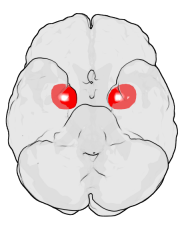
Photo from wikipedia
Tobacco smoking is one of the leading causes of preventable death and disease worldwide. Most smokers want to quit, but relapse rates are high. To improve current smoking cessation treatments,… Click to show full abstract
Tobacco smoking is one of the leading causes of preventable death and disease worldwide. Most smokers want to quit, but relapse rates are high. To improve current smoking cessation treatments, a better understanding of the underlying mechanisms of nicotine dependence and related craving behaviour is needed. Studies on cue-driven cigarette craving have been a particularly useful tool for investigating the neural mechanisms of drug craving. Here, functional neuroimaging studies in humans have identified a core network of craving-related brain responses to smoking cues that comprises of amygdala, anterior cingulate cortex, orbitofrontal cortex, posterior cingulate cortex and ventral striatum. However, most functional Magnetic Resonance Imaging (fMRI) cue-reactivity studies do not adjust their stimuli for emotional valence, a factor assumed to confound craving-related brain responses to smoking cues. Here, we investigated the influence of emotional valence on key addiction brain areas by disentangling craving- and valence-related brain responses with parametric modulators in 32 smokers. For one of the suggested key regions for addiction, the amygdala, we observed significantly stronger brain responses to the valence aspect of the presented images than to the craving aspect. Our results emphasize the need for carefully selecting stimulus material for cue-reactivity paradigms, in particular with respect to emotional valence. Further, they can help designing future research on teasing apart the diverse psychological dimensions that comprise nicotine dependence and, therefore, can lead to a more precise mapping of craving-associated brain areas, an important step towards more tailored smoking cessation treatments.
Journal Title: Addiction biology
Year Published: 2021
Link to full text (if available)
Share on Social Media: Sign Up to like & get
recommendations!